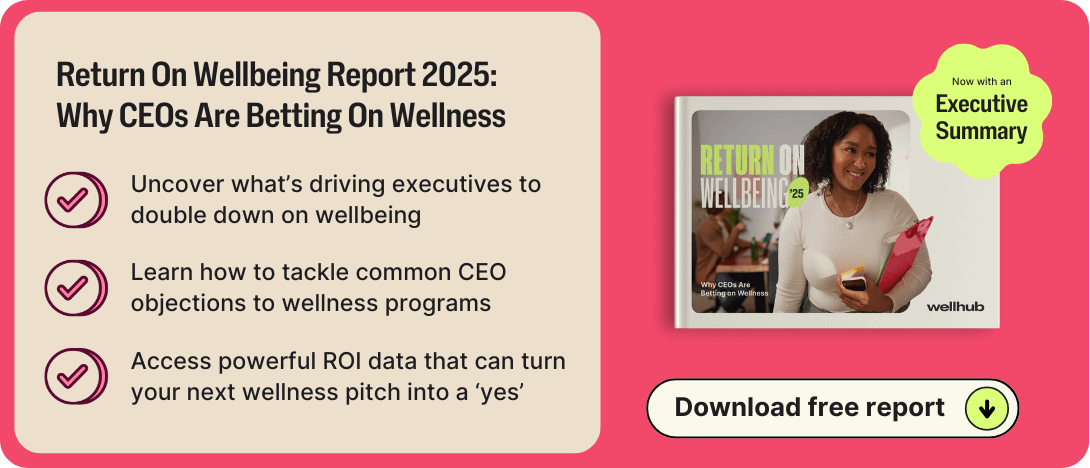5 Ways HR Can Overcome C-Suite Objections to Wellness Programs
Last Updated Jul 2, 2025

Ever pitched a wellness program and felt instant resistance? You're not alone.
Our recent Wellhub report, Return on Wellbeing 2025: The CEO Edition, reveals that not a single executive gave a wellness initiative an automatic thumbs-up. Even leaders passionate about employee health need convincing—questions and concerns naturally pop up.
The stakes are high. Without strong, data-backed arguments, your initiative might stall before it even gets off the ground, leaving valuable opportunities untapped and employee wellbeing unaddressed.
Here's the good news: Employee engagement data and clear ROI metrics are your secret weapons. Nearly half (49%) of CEOs agree that feedback and proven business outcomes overcome their objections.
Anticipate these hurdles, present rock-solid evidence, and you'll make wellbeing your company's strategic advantage. Here’s how!

Objection 1: Our Employees Won’t Use a Wellness Program
Many C-suite leaders are laser-focused on one major challenge when it comes to employee wellness: engagement. In fact, 30% say their biggest hesitation about investing in a wellness program is the fear that employees just won’t use it.
If this is a concern you’re hearing from your C-suite, here’s what helped other execs overcome their hesitation.
Solution 1: Present Clear, Compelling Data
Solution 2: Highlight Employee Demand
Solution 3: Showcase Simple and Accessible Programs
Solution 4: Position Wellness as Strategic
Solution 5: Commit Leadership Visibility
Objection 2: We Have Other Budget Priorities
With 94% of CEOs allocating budgets for wellness programs, it's clear that employee wellbeing is a top priority at the highest level. But cost is still a big hurdle for some. Nearly a third (29%) of CEOs cite high implementation costs as a key concern—second only to low employee engagement. Other budget-related worries include competing priorities (22%) and justifying expenses to shareholders (14%).
So, how do you handle budget objections? Here’s a strategic approach to make the case for wellness investments.
Solution 1: Showcase Cost-Efficient Wellness Activities
Solution 2: Align Wellness with Employee Productivity Metrics
Solution 3: Leverage Existing Employee Benefit Investments
Solution 4: Provide Clear Communication to Stakeholders:
Objection 3: We’re Already Supporting Employee Wellbeing
Some CEOs believe their organization already “does enough” for employee wellbeing. Maybe there’s an EAP in place or an occasional mental health webinar. That’s a start—but it’s not a strategy. If that sounds familiar, here’s how you can help your leader see the bigger picture.
Solution 1: Highlight the Difference Between Reactive and Proactive Programs
Solution 2: Present Comprehensive, Holistic Programs
Solution 3: Demonstrate the Strategic Value of Comprehensive Wellness
Solution 4: Identify Gaps and Opportunities
Solution 5: Share Employee Voices and Success Stories
Objection 4: Wellness Programs Don’t Actually Improve Employee Wellbeing
Skepticism about impact is a common blocker at the executive level. Some CEOs question whether wellness programs truly improve employee health or simply check a box. They want to see real outcomes—not just good intentions. If your leadership team is looking for proof, here’s how to build a case grounded in results.
Solution 1: Share Proven Industry Outcomes
Solution 2: Introduce Benchmarked Assessments
Solution 3: Utilize Third-Party Validation
Solution 4: Feature Employee Voices Pre-Implementation
Objection 5: Wellness Programs Are Too Difficult to Manage
Some CEOs (21%) worry that wellness programs will overload HR with extra work.
But the truth is, the right approach makes them seamless, effective, and often easier to manage than doing nothing. The CEOs who’ve moved past this concern did it by listening to employees, getting leadership buy-in, learning from their peers, running pilot programs, and focusing on ROI.
Here’s how HR can turn hesitation into full-speed-ahead momentum.
Solution 1: Highlight Simple and Automated Solutions
Solution 2: Leverage Third-Party Expertise
Solution 3: Emphasize Leadership and Employee Involvement
Solution 4: Present Clear and Efficient Reporting
Turn Wellness Objections into Opportunities for Growth
Executive concerns about engagement, budget, and complexity aren't chances to build a stronger business case for employee wellbeing. Addressing these proactively creates room to showcase measurable ROI and real employee success stories.
Employee wellbeing programs make a tangible difference, increasing employee engagement and reducing turnover. In fact, 90% of companies measuring their wellness initiatives see clear, positive returns. This makes wellness an investment that aligns closely with your company’s strategic goals.
Speak with a Wellhub Wellbeing Specialist to unlock the potential of wellbeing and create a thriving workplace.
Category
Share

The Wellhub Editorial Team empowers HR leaders to support worker wellbeing. Our original research, trend analyses, and helpful how-tos provide the tools they need to improve workforce wellness in today's fast-shifting professional landscape.
Subscribe
Our weekly newsletter is your source of education and inspiration to help you create a corporate wellness program that actually matters.
Subscribe
Our weekly newsletter is your source of education and inspiration to help you create a corporate wellness program that actually matters.
You May Also Like

Wellness Points Programs: Boost Employee Health & Engagement | Wellhub
Turn your workplace wellness strategy around with a points program that rewards healthy behavior with perks, from extra time off to gift cards.

Employee Financial Wellness Programs: Ultimate HR Guide | Wellhub
Create an effective financial wellness program that supports your employees in their financial needs, boosting productivity and retention.

6 Ways to Mental Health Support at Work | Wellhub
Transform your workplace with effective mental health support strategies to reduce stress, prevent burnout, and create a thriving company culture.